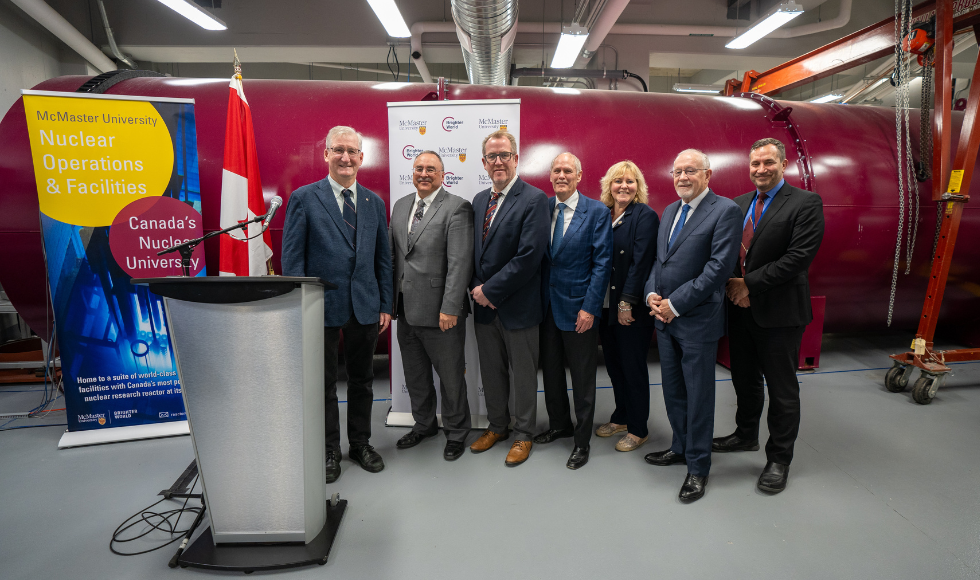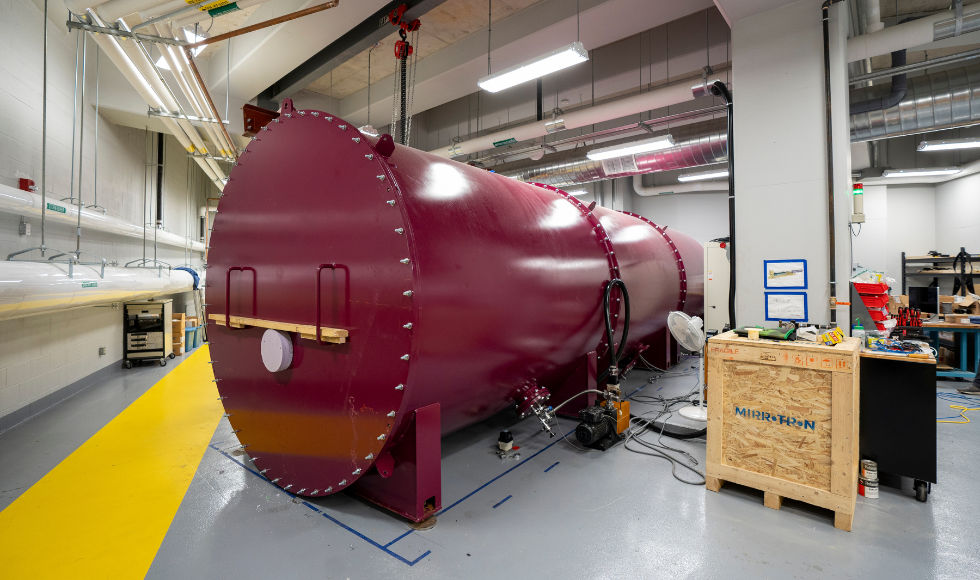McMaster celebrates launch of new Canadian Neutron Beam Laboratory

The Canadian Neutron Beam Laboratory at McMaster will enable scientists from Canada and around the world to advance critical research in clean energy, clean transportation, advanced manufacturing, medicine and more. (From left to right) Bruce Gaulin, McMaster Distinguished University Professor; Sylvain Charbonneau, president and CEO of the CFI; Andy Knights, vice-president, research (acting); David Farrar, president of McMaster; Susan Tighe, provost and vice-president (Academic); John Barrett, chair of the board of Neutrons Canada and Dave Tucker, assistant vice-president research (Nuclear).
November 15, 2024
McMaster University and Neutrons Canada celebrated the launch of the Canadian Neutron Beam Laboratory (CNBL) — a new suite of facilities built to advance neutron beam research in Canada.
Neutron beams are an essential tool for materials research and innovation. They can penetrate deep into dense materials like metals, making it possible to visualize the interior of an object at the atomic scale without physically damaging it.
The CNBL, located at McMaster University, will ensure scientists from Canada and around the world have access to these versatile and irreplaceable tools for understanding materials.
The CNBL was funded through $57 million in investments from federal and provincial sources, anchored by funding from the Canada Foundation for Innovation (CFI) as part of the multi-institutional Building a Future for Canadian Neutron Scattering project.
Bruce Gaulin, Distinguished University Professor and faculty member of the Department of Physics and Astronomy, says the new lab will strengthen Canada’s neutron beam science capacity and ensure the country remains competitive on the global research stage.
“Canada and McMaster have a remarkable history of innovation in neutron beam science that stretches back to the 1950s,” he says, noting Nobel Prize winner Bertram Brockhouse’s groundbreaking contributions to the field.
“The next generation of innovations in health, science and technology will depend on the discovery and development of new materials, aided by research using neutron beams. We’re so excited to offer Canadian scientists direct access to the CNBL and its leading-edge instruments.”
The McMaster Nuclear Reactor is currently the only facility in Canada with neutron beam research infrastructure and one of only seven in North America.
Leveraging existing infrastructure at McMaster in addition to new instruments, the CNBL will support research and development in a wide range of fields — including clean energy technologies, superconductors, materials for advanced manufacturing, biomaterials for understanding and combating disease, and quantum materials that could enable breakthroughs in information technology devices.
Neutrons Canada — an independent organization of fifteen leading Canadian universities and Canadian Nuclear Laboratories advancing research and development with neutron beams — are close partners with McMaster in developing national neutron beam science infrastructure.
“Neutrons Canada congratulates McMaster University on the establishment of the Canadian Neutron Beam Laboratory,” says John Barrett, chair of the board of Neutrons Canada.
“The CNBL will be an essential resource for rejuvenating Canada’s historic leadership in materials research with neutron beams. We look forward to collaborating closely with CNBL as part of Neutrons Canada’s ambition to build a nation-wide R&D infrastructure program for the Canadian neutron beam community.”

Leaders and nuclear experts from McMaster, CFI and Neutrons Canada gathered at the McMaster Small Angle Neutron Scattering Facility (MacSANS), located adjacent to the McMaster Nuclear Reactor, to celebrate the official launch of the CNBL.
MacSANS is one of five neutron scattering instruments that will be housed in the CNBL and one of two that are already operational.
Gaulin says the goal is to support approximately 200 user groups once CNBL is fully completed — including researchers and students from dozens of Canadian academic institutions.
“The opening of these beamlines at the McMaster Nuclear Reactor answers a pressing need for world-class researchers working to improve Canadians’ health and environment, as well as enhance our competitiveness in key industries, including energy production and automotive manufacturing,” says Sylvain Charbonneau, President and CEO of the CFI.
“This CFI-funded facility will grow international scientific partnerships and be used by experts from numerous Canadian universities.”
McMaster and Neutrons Canada also plan to build international partnerships so that Canadian researchers can access world-leading neutron sources in the United States and globally.
Andy Knights, McMaster’s vice-president, research (acting), thanks the CFI and Neutrons Canada for their partnership and shared dedication to securing the future of neutron beam science in Canada.
“McMaster is proud to work with our partners in neutron beam science to ensure the country’s innovators are well-equipped to advance discoveries that benefit Canadians and enhance our competitiveness, while training the next generation of experts in the field,” says Knights.


